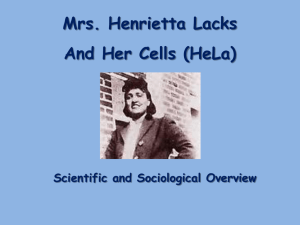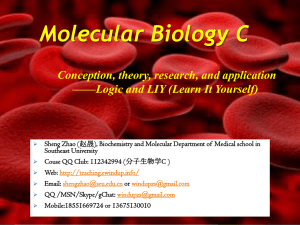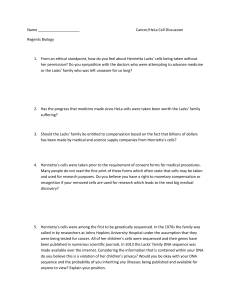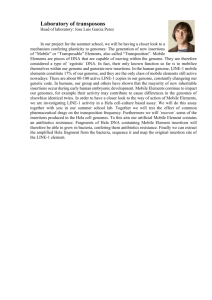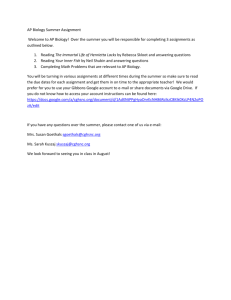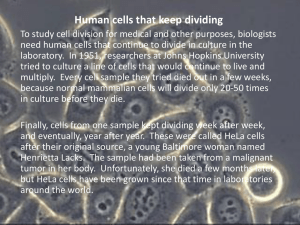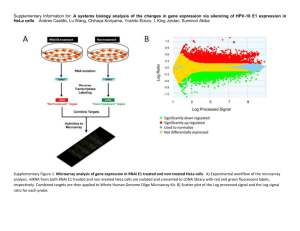Grade 10 ELA Module 3, Unit 1, Lesson 4
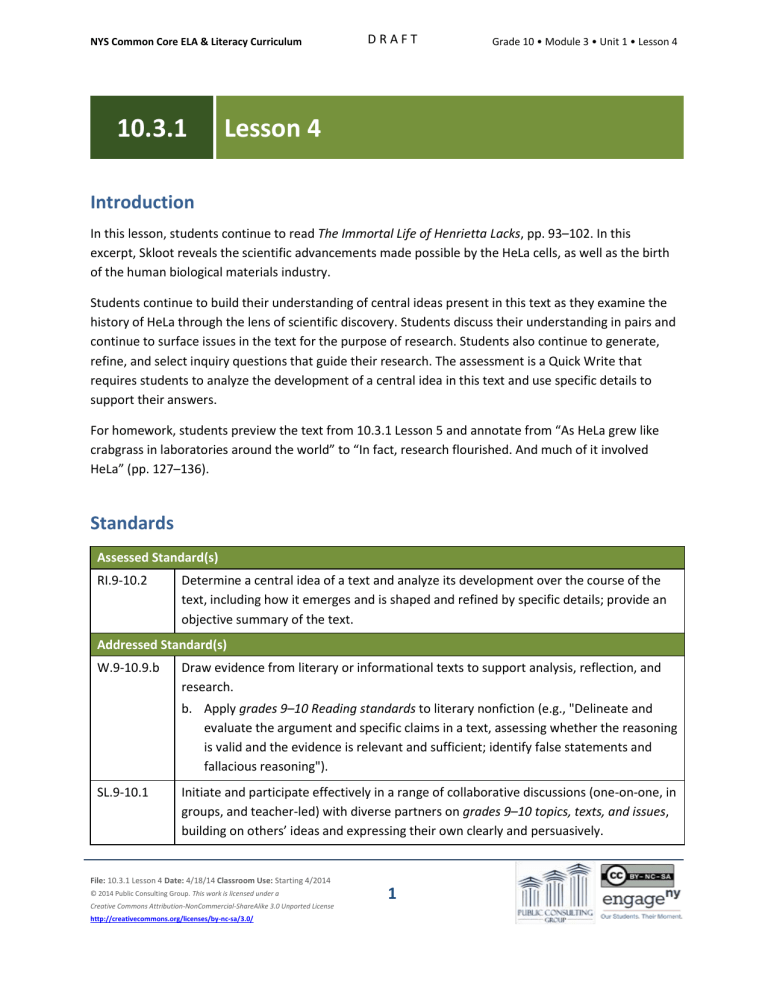
NYS Common Core ELA & Literacy Curriculum
10.3.1 Lesson 4
D R A F T
Grade 10 • Module 3 • Unit 1 • Lesson 4
Introduction
In this lesson, students continue to read The Immortal Life of Henrietta Lacks, pp. 93–102. In this excerpt, Skloot reveals the scientific advancements made possible by the HeLa cells, as well as the birth of the human biological materials industry.
Students continue to build their understanding of central ideas present in this text as they examine the history of HeLa through the lens of scientific discovery. Students discuss their understanding in pairs and continue to surface issues in the text for the purpose of research. Students also continue to generate, refine, and select inquiry questions that guide their research. The assessment is a Quick Write that requires students to analyze the development of a central idea in this text and use specific details to support their answers.
For homework, students preview the text from 10.3.1 Lesson 5 and annotate from “As HeLa grew like crabgrass in laboratories around the world” to “In fact, research flourished. And much of it involved
HeLa” (pp. 127–136).
Standards
Assessed Standard(s)
RI.9-10.2 Determine a central idea of a text and analyze its development over the course of the text, including how it emerges and is shaped and refined by specific details; provide an objective summary of the text.
Addressed Standard(s)
W.9-10.9.b Draw evidence from literary or informational texts to support analysis, reflection, and research. b.
Apply grades 9–10 Reading standards to literary nonfiction (e.g., "Delineate and evaluate the argument and specific claims in a text, assessing whether the reasoning is valid and the evidence is relevant and sufficient; identify false statements and fallacious reasoning").
SL.9-10.1 Initiate and participate effectively in a range of collaborative discussions (one-on-one, in groups, and teacher-led) with diverse partners on grades 9–10 topics, texts, and issues, building on others’ ideas and expressing their own clearly and persuasively.
File: 10.3.1 Lesson 4 Date: 4/18/14 Classroom Use: Starting 4/2014
© 2014 Public Consulting Group. This work is licensed under a
Creative Commons Attribution-NonCommercial-ShareAlike 3.0 Unported License http://creativecommons.org/licenses/by-nc-sa/3.0/
1
NYS Common Core ELA & Literacy Curriculum
D R A F T
Grade 10 • Module 3 • Unit 1 • Lesson 4
Assessment
Assessment(s)
Student learning is assessed via a Quick Write at the end of the lesson. Students respond to the following prompt, citing textual evidence to support analysis and inferences drawn from the text.
Determine a central idea in this excerpt and analyze how specific details about HeLa cells contribute to its development.
High Performance Response(s)
A High Performance Response should:
Determine a central idea present in this text (e.g., HeLa’s positive contributions to scientific development including the scientific discoveries made possible by HeLa cells, the development of a vaccine for polio using HeLa, the beginning of the “first industrial-scale, for-profit cell distribution center,” and dramatic improvements to the field of tissue culture).
Select details to illustrate the development of that central idea (e.g., the polio vaccine production forced Gey to develop a way to “make sure cells could survive long trips.” The large scale production and shipping method made it possible for many scientists to have access to the cells and presented opportunities for many scientific discoveries such as the “cloning of individual cells.”).
Vocabulary
Vocabulary to provide directly (will not include extended instruction)
polio (n.) – shortened form of poliomyelitis; a serious disease that affects the nerves of the spine and often makes a person permanently unable to move particular muscles
vaccine (n.) – a substance that is usually injected into a person or animal to protect against a particular disease
autoclave (n.) – a heavy vessel for conducting chemical reactions under high pressure
incubators (n.) – apparatus in which media inoculated with microorganisms are cultivated at a constant temperature
proteins (n.) – any of various naturally occurring extremely complex substances that consist of amino-acid residues joined by peptide bonds; contain the elements carbon, hydrogen, nitrogen, oxygen, usually sulfur, and occasionally other elements (such as phosphorus or iron); and include many essential biological compounds (such as enzymes, hormones, or antibodies)
optimal (adj.) – most favorable
File: 10.3.1 Lesson 4 Date: 4/18/14 Classroom Use: Starting 4/2014
© 2014 Public Consulting Group. This work is licensed under a
Creative Commons Attribution-NonCommercial-ShareAlike 3.0 Unported License http://creativecommons.org/licenses/by-nc-sa/3.0/
2
NYS Common Core ELA & Literacy Curriculum
D R A F T
Grade 10 • Module 3 • Unit 1 • Lesson 4
hardy (adj.) – capable of enduring hardship; strong
metabolism (n.) – the chemical processes by which a plant or animal uses food, water, etc. to grow and heal and to make energy culture medium (n.) – a liquid or solidified nutrient material suitable for the cultivation of microorganisms
culture was defined in 10.3.1 Lesson 1.
Vocabulary to teach (may include direct word work and/or questions)
susceptible (adj.) – open, subject, or unresistant to some stimulus, influence, or agency
Lesson Agenda/Overview
Student-Facing Agenda
Standards & Text:
Standards: RI.9-10.2, W.9-10.9.b, SL.9-10.1
Text: The Immortal Life of Henrietta Lacks, pages 93–102
Learning Sequence:
1.
Introduction of Lesson Agenda
2.
Homework Accountability
3.
Reading and Discussion
4.
Generating and Refining Inquiry Questions
5.
Quick Write
6.
Closing
Materials
Student copies of the Surfacing Issues Tool (refer to 10.3.1 Lesson 3)
Student copies of the 10.3.1 Unit Glossary (refer to 10.3.1 Lesson 1)
Student copies of the Posing Inquiry Questions Handout (refer to 10.3.1 Lesson 3)
Student copies of the Short Response Rubric and Checklist (refer to 10.3.1 Lesson 1)
% of Lesson
1.
5%
2.
15%
3.
45%
4.
20%
5.
10%
6.
5%
File: 10.3.1 Lesson 4 Date: 4/18/14 Classroom Use: Starting 4/2014
© 2014 Public Consulting Group. This work is licensed under a
Creative Commons Attribution-NonCommercial-ShareAlike 3.0 Unported License http://creativecommons.org/licenses/by-nc-sa/3.0/
3
NYS Common Core ELA & Literacy Curriculum
D R A F T
Grade 10 • Module 3 • Unit 1 • Lesson 4
Learning Sequence
How to Use the Learning Sequence
Symbol Type of Text & Interpretation of the Symbol
10% Percentage indicates the percentage of lesson time each activity should take.
Plain text indicates teacher action. no symbol
Bold text indicates questions for the teacher to ask students.
Italicized text indicates a vocabulary word.
Indicates student action(s).
Indicates possible student response(s) to teacher questions.
Indicates instructional notes for the teacher.
Activity 1: Introduction of Lesson Agenda 5%
Begin by reviewing the agenda and assessed standard for this lesson: RI.9-10.2. Explain that today students continue reading and analyzing pages 93–102 of The Immortal Life of Henrietta Lacks, focusing on the development of a central idea. Students also track potential research issues, as well as generate and refine further inquiry questions for research purposes.
Students look at the agenda.
Activity 2: Homework Accountability 15%
Instruct students to Turn-and-Talk with a classmate about the information they found for homework related to the Tuskegee syphilis study.
Differentiation Consideration: Consider leading a brief whole-class discussion in order to clarify the history of the study and provide students an opportunity to discuss their findings and opinions as a group before pair discussion.
This is a highly sensitive, racially charged issue; however, addressing this study is crucial to understanding the issues present in this text. Consider establishing and modeling classroom norms and expectations for a respectful and critical approach to sensitive topics in an academic context.
Students Turn-and-Talk with a classmate, discussing the information they found for homework.
The Tuskegee syphilis study was a scientific study done in Alabama. In this study, African-
American men who had syphilis were not given medicine to treat the syphilis when it became available by white doctors, but were observed to see if the effects of syphilis were different between African-Americans and white Americans. Many of the men in the study died from syphilis.
File: 10.3.1 Lesson 4 Date: 4/18/14 Classroom Use: Starting 4/2014
© 2014 Public Consulting Group. This work is licensed under a
Creative Commons Attribution-NonCommercial-ShareAlike 3.0 Unported License http://creativecommons.org/licenses/by-nc-sa/3.0/
4
NYS Common Core ELA & Literacy Curriculum
D R A F T
Grade 10 • Module 3 • Unit 1 • Lesson 4
Ask students:
How did the resources you found help you understand these terms?
Student pairs discuss the resources they found and how it helped them understand the
Tuskegee syphilis study.
Student responses vary depending on the resource but may include: o This article (“Tuskegee Syphilis Study”) on Science Museum ( www.sciencemuseum.org.uk
) helped me understand the study because it presents a brief account of what happened to the men and gives the dates of when the study started and ended. It also mentions that some of the men who were a part of the study were not allowed to be drafted and fight in
World War II.
Activity 3: Reading and Discussion 45%
Instruct students to form pairs. Post or project each set of questions below for students to discuss.
Instruct students to take out their Surfacing Issues Tools, and reread The Immortal Life of Henrietta
Lacks, from “Not long after Henrietta’s death, planning began” to “were conducting the infamous
Tuskegee syphilis studies” (pp. 93–97) and answer the following questions before sharing out with the class.
If necessary to support comprehension and fluency, consider using a Masterful Reading of the focus excerpt for the lesson.
Direct student pairs to also annotate the text, surface issues, and record their answers in writing.
Remind students to record issues for research as they read on their Surfacing Issues Tool.
Instruct students to consult the 10.3.1 Unit Glossary for the terms found in today’s reading including: polio, vaccine, autoclave, incubator, culture medium, hardy, optimal, proteins, and
metabolism.
This annotation supports students’ engagement with W.9-10.9.b, which addresses the use of textual evidence in writing.
For potential student issues surfaced for this reading see the Model Surfacing Issues Tool at the end of this lesson.
What was the problem with Salk’s polio vaccine? How did HeLa solve this problem?
There needed to be “millions of neutralization tests” (p. 93), which cost a lot of money because
“monkeys were expensive” (p. 94). HeLa cells could be easily grown on a massive scale, which
File: 10.3.1 Lesson 4 Date: 4/18/14 Classroom Use: Starting 4/2014
© 2014 Public Consulting Group. This work is licensed under a
Creative Commons Attribution-NonCommercial-ShareAlike 3.0 Unported License http://creativecommons.org/licenses/by-nc-sa/3.0/
5
NYS Common Core ELA & Literacy Curriculum
D R A F T
Grade 10 • Module 3 • Unit 1 • Lesson 4 was cheaper than buying monkeys; “HeLa cells weren’t limited by space . . . it would solve the mass production problem” (p. 94–95).
What is the significance of HeLa cells being “more susceptible to the virus than any other cultured cells” (p. 95)?
Scientists needed to see if “the virus would infect the cells” (p. 94), to figure out if the vaccine worked. Since HeLa is “more susceptible” it meant that the virus would infect the cell faster and results would be seen quickly.
What is the meaning of the word susceptible (p. 94)?
HeLa needed to be “susceptible to poliovirus” (p. 94) in order to be effective for testing.
Susceptible might mean easily affected by a virus.
How did Gey play a role in proving the polio vaccine effective?
Gey gave away a vial of HeLa cells in a shipping experiment and that allowed the Tuskegee
Institute to mass-produce HeLa cells to prove the vaccine's effectiveness: “It was the first-ever cell production factory, and it started with a single vial of HeLa that Gey had sent Schrerer in their first shipping experiment, not long after Henrietta's death” (p. 96).
What contrast does Skloot present at the end of pages 93–97? How does the homework assignment concerning the Tuskegee syphilis study deepen your understanding of this contrast?
Remind students to refer to the research they completed for homework.
Skloot contrasts “Black scientists and technicians . . . cells from a black woman” (p. 97) of the
Tuskegee Institute with the Americans who benefited from the polio vaccine, “most of them white” (p. 97). The research on the Tuskegee syphilis study deepens this contrast because not only were black scientists working to help white patients, but at the same institute there were white scientists actively doing harm to black patients.
Lead a brief whole-class discussion of student responses.
Instruct student pairs to read The Immortal Life of Henrietta Lacks, from “At first the Tuskegee Center supplied HeLa cells” to “which glassware and test-tube stoppers were least toxic to cells” (pp. 97–99) and answer the following questions before sharing out with the class. Also direct student pairs to annotate the text and record the answers in writing. Remind students to record potential issues for research as they read on the Surfacing Issues Tool.
What made HeLa cells an “optimal (most favorable) tool” (p. 97) for studying cell behavior?
File: 10.3.1 Lesson 4 Date: 4/18/14 Classroom Use: Starting 4/2014
© 2014 Public Consulting Group. This work is licensed under a
Creative Commons Attribution-NonCommercial-ShareAlike 3.0 Unported License http://creativecommons.org/licenses/by-nc-sa/3.0/
6
NYS Common Core ELA & Literacy Curriculum
D R A F T
Grade 10 • Module 3 • Unit 1 • Lesson 4
HeLa cells could be used to study “any number of things in culture” (p. 97) and shared “many basic characteristics with normal cells” (p. 97), but they “produced results faster” (p. 97).
How did HeLa cells allow scientists to view “spontaneous transformation”?
Researchers used HeLa to develop “methods for freezing cells” (p. 98), and since they could freeze cells they could look at “identical cells at different points in time” (p. 98). Spontaneous transformation is the point at which a “normal cell . . . became malignant” (p. 98) and by freezing cells, researchers could see when this happened.
Why was standardization of materials and methods important for scientific study? Provide two examples of how HeLa cells contributed to standardization.
Standardization was important because an experiment “isn’t considered valid if others can’t repeat the work” (p. 99). HeLa cells were used to develop the “first standardized culture medium,” as well as test which glassware were “least toxic to cells” (p. 99).
Lead a brief whole-class discussion of student responses.
Instruct student pairs to read The Immortal Life of Henrietta Lacks, from “Only then, for the first time, could researchers around the world” to “But none grew in quantities like HeLa” (pp. 99–102) and answer the following questions before sharing out with the class. Also direct student pairs to annotate the text and record answers in writing. Remind students to record potential issues for research as they read on the Surfacing Issues Tool.
Why was it necessary to clone HeLa cells?
Scientists wanted to clone individual cells because they “often behave differently” (p. 99) even if they are from the same cluster. Scientists needed to clone cells in order to use and understand each of their “unique traits” (p. 100).
What was the “fortunate mistake”? How did this contribute to scientific understanding?
The “fortunate mistake” was an accidental mixing of a liquid with “HeLa and a few other cells”
(p. 100) that allowed scientists to see all the chromosomes clearly. This allowed scientists to know exactly “how many chromosomes people were supposed to have,” and allowed scientific discovery in the field of “chromosomal disorders” (p. 100).
How was Microbiological Associates “an absolute revolution in the field” (p. 101)? Use evidence from the text to support your answer.
File: 10.3.1 Lesson 4 Date: 4/18/14 Classroom Use: Starting 4/2014
© 2014 Public Consulting Group. This work is licensed under a
Creative Commons Attribution-NonCommercial-ShareAlike 3.0 Unported License http://creativecommons.org/licenses/by-nc-sa/3.0/
7
NYS Common Core ELA & Literacy Curriculum
D R A F T
Grade 10 • Module 3 • Unit 1 • Lesson 4
Microbiological Associates and Samuel Reader were the first to create a “for-profit cell distribution center” (p. 101). They used HeLa cells to create a “multibillion-dollar industry” (p.
101) because no one had the “time or ability” (p. 100) to grow HeLa cells in large amounts.
How does the quote, “HeLa was a workhorse: it was hardy (capable of enduring hardship; strong), it
was inexpensive, and it was everywhere” (p. 97) help develop the central ideas in this portion of text?
Since HeLa was “a workhorse” (p. 97) and “hardy” (p. 97), it was able to produce results quickly and “made several important scientific advances” (p. 98). One of these advancements was helping scientists understand “how many chromosomes people were supposed to have” (p.
100). HeLa cells were “inexpensive” (p. 97) and many scientists wanted them for experiments,
“but few had the time or ability to grow them” (p. 100) so instead scientists just bought them.
The demand for HeLa was so great it helped launch a “multibillion-dollar industry” (p. 101), which started with Samuel Reader’s “Cell Factory” (p. 101).
Remind students they have been introduced to workhorse in 10.3.1 Lesson 1 and instruct them to consult the Unit 10.3.1 Unit Glossary for a definition.
Lead a brief whole-class discussion of student responses.
Activity 4: Generating and Refining Inquiry Questions 20%
Explain to students that in this lesson, they continue the work of collaborative discussion outlined in
SL.9-10.1, to which students were previously introduced. Remind students that in the previous lesson, they were introduced to generating and refining inquiry questions to support rich inquiry and research.
Instruct students to first form heterogeneous groups of four or five, and ask each group to generate five inquiry questions based on the issues recorded in this lesson. Instruct students to use the selecting and refining process introduced in the previous lesson to select their strongest inquiry questions. Instruct students to refer to their Posing Inquiry Questions Handout as they generate, refine, and select inquiry questions.
Consider reminding students of the skills inherent in the substandards of SL.9-10.1, to which students were previously introduced.
Remind students that the process of selecting and refining inquiry questions helps them identify the strongest questions for further inquiry.
Students form groups and generate and refine inquiry questions.
Student responses vary depending on the topic, inquiry questions, and refining process, but may include: o Issue: Cell cloning
File: 10.3.1 Lesson 4 Date: 4/18/14 Classroom Use: Starting 4/2014
© 2014 Public Consulting Group. This work is licensed under a
Creative Commons Attribution-NonCommercial-ShareAlike 3.0 Unported License http://creativecommons.org/licenses/by-nc-sa/3.0/
8
NYS Common Core ELA & Literacy Curriculum
D R A F T
Grade 10 • Module 3 • Unit 1 • Lesson 4 o Inquiry questions: 1.What is the history of cell cloning? 2. What are the major aspects of cell cloning? 3. What else is cell cloning associated with? 4. What have been the implications or discoveries made possible by cell cloning? 5. Who are the scientists who first grew cell clones?
Through selecting and refining inquiry questions, student groups identify their strongest questions to guide their initial searches in subsequent lessons.
Activity 5: Quick Write
Instruct students to respond briefly in writing to the following prompt:
10%
Determine a central idea in this excerpt and analyze how specific details about HeLa cells contribute to its development.
Instruct students to look at their annotations to find evidence. Ask students to use this lesson’s vocabulary wherever possible in their written responses. Remind students to use the Short Response
Rubric and Checklist to guide their written responses.
Display the prompt for students to see, or provide the prompt in hard copy.
Students independently answer the prompt, using evidence from the text.
See the High Performance Response at the beginning of this lesson.
Activity 6: Closing
Display and distribute the homework assignment. For homework, instruct students to read and annotate from “As HeLa grew like crabgrass in laboratories around the world” to “In fact, research flourished. And much of it involved HeLa” (pp. 127–136). Direct students to box any unfamiliar words and look up their definitions. Instruct them to choose the definition that makes the most sense in the context, and write a brief definition above or near the word in the text.
Students follow along.
5%
Homework
Read and annotate from “As HeLa grew like crabgrass in laboratories around the world” to “In fact, research flourished. And much of it involved HeLa” (pp. 127–136). Box any unfamiliar words and look up their definitions. Choose the definition that makes the most sense in the context, and write a brief definition above or near the word in the text.
File: 10.3.1 Lesson 4 Date: 4/18/14 Classroom Use: Starting 4/2014
© 2014 Public Consulting Group. This work is licensed under a
Creative Commons Attribution-NonCommercial-ShareAlike 3.0 Unported License http://creativecommons.org/licenses/by-nc-sa/3.0/
9
NYS Common Core ELA & Literacy Curriculum
Model Surfacing Issues Tool
Name:
Issue
Class:
D R A F T
Page Number(s)
Grade 10 • Module 3 • Unit 1 • Lesson 4
Date:
Cloning cells
Racial inequality
Biological materials industry
Polio vaccine
99–100
96–97
100–101
93–97
Key Information About the
Issue from the Text
Cell cloning was used because
HeLa came from “a cluster of cells” and scientists wanted to grow and study traits of individual cells. The advancements made with cell cloning “helped lead to many later advances.”
Black scientists and technicians were studying and using cells
“from a black woman” to help save the lives of millions of white Americans.
There was a great demand for
HeLa cells and Microbiological
Associates began producing
HeLa cells in large quantities and made millions of dollars.
HeLa cells were used for
“neutralization tests” because they were cheap, easy to produce, and very susceptible to the poliovirus.
From Odell Education Researching to Deepen Understanding Framework, by Odell Education, www.odelleducation.com.
Copyright (2013) by Odell Education. Adapted with permission under an Attribution-NonCommercial 3.0 Unported license: http://creativecommons.org/licenses/by-nc/3.0/ .
File: 10.3.1 Lesson 4 Date: 4/18/14 Classroom Use: Starting 4/2014
© 2014 Public Consulting Group. This work is licensed under a
Creative Commons Attribution-NonCommercial-ShareAlike 3.0 Unported License http://creativecommons.org/licenses/by-nc-sa/3.0/
10
